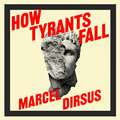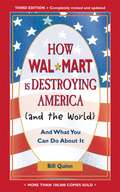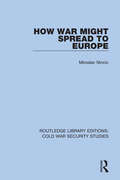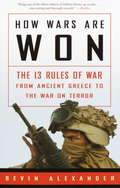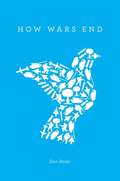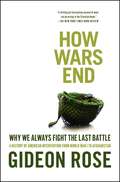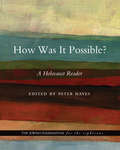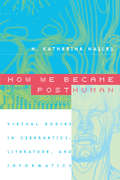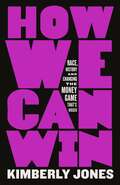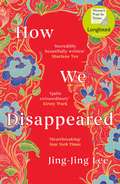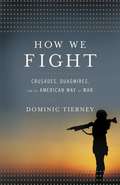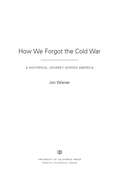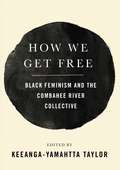- Table View
- List View
How Tyrants Fall: And How Nations Survive
by Marcel Dirsus'Gripping . . . essential and captivating' BRADLEY HOPE'A sparkling read full of original observations and captivating insights' KATJA HOYER'Utterly compelling . . . jaw-dropping' BRIAN KLAAS'Fascinating, wide-ranging . . . highly-entertaining' PETER GEOGHEGANStrongmen are rising. Democracies are faltering. How does tyranny end?Tyrants project invincibility, but all of them fall. This is because they face critical weaknesses that can form a fatal trap. Whether it's their inner circle turning against them or resentment of elites in the military, the masses alienated by cronyism or revolutionaries plotting in exile, tyrants always have more enemies than friends. And when they fall tyrants don't quietly retire - they face exile, prison or death. What happens in the aftermath can change the fate of a nation.Meeting with coup leaders, dissidents and soldiers, political scientist Marcel Dirsus draws on extraordinary interviews to examine the workings and malfunctions of tyrants. We hear from a revolutionary (codename 'Satan') who risked Stasi capture to undermine an oppressive regime, an unapologetic former leader of a Burundian rebel group which carried out a massacre, and an American-Gambian activist who plotted to liberate his homeland on breaks during his construction job. But understanding dictators isn't enough. How Tyrants Fall is the gripping, deeply researched blueprint for how to bring them down.
How Tyrants Fall: And How Nations Survive
by Marcel Dirsus'Gripping . . . essential and captivating' BRADLEY HOPE'A sparkling read full of original observations and captivating insights' KATJA HOYER'Utterly compelling . . . jaw-dropping' BRIAN KLAAS'Fascinating, wide-ranging . . . highly-entertaining' PETER GEOGHEGANStrongmen are rising. Democracies are faltering. How does tyranny end?Tyrants project invincibility, but all of them fall. This is because they face critical weaknesses that can form a fatal trap. Whether it's their inner circle turning against them or resentment of elites in the military, the masses alienated by cronyism or revolutionaries plotting in exile, tyrants always have more enemies than friends. And when they fall tyrants don't quietly retire - they face exile, prison or death. What happens in the aftermath can change the fate of a nation.Meeting with coup leaders, dissidents and soldiers, political scientist Marcel Dirsus draws on extraordinary interviews to examine the workings and malfunctions of tyrants. We hear from a revolutionary (codename 'Satan') who risked Stasi capture to undermine an oppressive regime, an unapologetic former leader of a Burundian rebel group which carried out a massacre, and an American-Gambian activist who plotted to liberate his homeland on breaks during his construction job. But understanding dictators isn't enough. How Tyrants Fall is the gripping, deeply researched blueprint for how to bring them down.
How Tyrants Fall: And How Nations Survive
by Marcel Dirsus'Gripping . . . essential and captivating' BRADLEY HOPE'A sparkling read full of original observations and captivating insights' KATJA HOYER'Utterly compelling . . . jaw-dropping' BRIAN KLAAS'Fascinating, wide-ranging . . . highly-entertaining' PETER GEOGHEGANStrongmen are rising. Democracies are faltering. How does tyranny end?Tyrants project invincibility, but all of them fall. This is because they face critical weaknesses that can form a fatal trap. Whether it's their inner circle turning against them or resentment of elites in the military, the masses alienated by cronyism or revolutionaries plotting in exile, tyrants always have more enemies than friends. And when they fall tyrants don't quietly retire - they face exile, prison or death. What happens in the aftermath can change the fate of a nation.Meeting with coup leaders, dissidents and soldiers, political scientist Marcel Dirsus draws on extraordinary interviews to examine the workings and malfunctions of tyrants. We hear from a revolutionary (codename 'Satan') who risked Stasi capture to undermine an oppressive regime, an unapologetic former leader of a Burundian rebel group which carried out a massacre, and an American-Gambian activist who plotted to liberate his homeland on breaks during his construction job. But understanding dictators isn't enough. How Tyrants Fall is the gripping, deeply researched blueprint for how to bring them down.
How UFOs Conquered the World: The History of a Modern Myth
by David Clarke“Cover[s] all the major themes of ufology, ranging from lights in the sky to crashed saucers, government cover-ups and alien abductions . . . fascinating.” —Popular Science BooksNeither a credulous work of conspiracy theory nor a skeptical debunking of belief in “flying saucers,” How UFOs Conquered the World explores the origins of UFOs in the build-up to the First World War and how reports of them have changed in tandem with world events, science and culture. The book will also explore the overlaps between UFO belief and religion and superstition.“An insightful, informative and thought-provoking book on UFOs and the UFO culture . . . In the following ten chapters, he writes about his pursuit of the ‘truth’ about UFOs. It is a fascinating journey.” —Skeptic
How Underwear Got Under There: A Brief History
by Regan Dunnick Kathy ShaskanDid you know that warriors at the time of Genghis Khan invented arrow-resistant silk underwear? Or that the recommended age to begin wearing a corset in the late 1800s was four years old? Or that King Tut had a particular fondness for underwear? He was buried with 145 pairs!<P><P> This lively text consists of ten chapters on various aspects of underwear, including the social and historical ramifications of different undergarments and their development for warmth, support, protection, cleanliness, and status. Regan Dunnick’s clever illustrations and Kathy Shaskan's accessible text is giggle-worthy, page-turning, and well-researched. From boxers to bustles to briefs, from history to humor, from support to society, the story of underwear is the story of humanity itself.
How Walmart Is Destroying America (And the World): And What You Can Do about It
by Bill QuinnAfter carving up the once lovingly cared-for downtowns of Small Town America, Wal-Mart launched a frontal assault on mom-and-pop businesses all over the globe. With 1.5 million employees operating more than 3, 500 stores, Wal-Mart is now the world'¬?s largest private employer. In this third edition of How Wal-Mart Is Destroying America (and the World), intrepid Texas newspaperman Bill Quinn continues the fight. Featuring detailed accounts of Wal-Mart'¬?s questionable business practices and the latest information on Wal-Mart lawsuits, vendor issues, and efforts to stop expansion, Quinn shows why Wal-Mart Stores, Inc., is arguably the most feared and despised corporation in the world. Whether you'¬?re a customer fed up with Wal-Mart'¬?s false claims, a vendor squeezed by strong-arm tactics, a worker pushed to increase the Waltons'¬? bottom line, or a concerned citizen trying to save your hometown, this book will show you how to get Wal-Mart off your back and out of your backyard.BILL QUINN is a World War II veteran, retired newspaperman, and certified anti-Wal-Mart crusader. He lives with his wife, Lennie, in Grand Saline,Texas.From the Trade Paperback edition.
How War Begins
by John KeeganAn eBook short.From the dean of modern military historians, John Keegan: a key selection from his masterpiece, The First World War. The road to World War I, from the death of the archduke to the first salvos of battle, an incredibly thorough and straightforward account of how a supposedly rational liberal Europe became engulfed by war.Everyone remembers the powder keg, the assassination of Archduke Ferdinand and his wife by Serbian national Gavrilo Princip; but what about the fact that a full month elapsed between Princip's deed and the actual beginning of war? Or that the German Kaiser spent much of that time on his imperial yacht Hohenzollern, on his annual cruise in the Norwegian fjords? John Keegan explains in careful and fascinating detail how exactly the war began, taking the reader through this fateful and exciting month of diplomatic back and forth, last-minute near-saves, and ultimate failure.
How War Might Spread to Europe (Routledge Library Editions: Cold War Security Studies #27)
by Miroslav NincicThis book, first published in 1985, examines the Cold War risks of superpower confrontations, mainly in the Third World, resulting in war in Europe. European security is usually analysed in the context of East-West relations in Europe, where though tensions often ran high, actual war seemed remote. The risks of war were much greater in other parts of the world, where the United States and the Soviet Union confronted each other using proxies. This book analyses these proxy confrontations, and the risks that they posed to the security of Europe.
How Wars Are Won: The 13 Rules of War--from Ancient Greece to the War on Terror
by Bevin AlexanderFrom ancient Greece to the war on terror, the author of the acclaimed "How Hitler Could Have Won World War II" identifies the 13 rules of war that have determined victory and defeat from ancient times through the 21st century.
How Wars End
by Dan ReiterThe author helps solve some of the most enduring puzzles in military history, and argues that two central factors shape war-termination decision making: information about the balance of power and the resolve of one's enemy.
How Wars End
by Gideon RoseIN 1991 THE UNITED STATES trounced the Iraqi army in battle only to stumble blindly into postwar turmoil. Then in 2003 the United States did it again. How could this happen? How could the strongest power in modern history fight two wars against the same opponent in just over a decade, win lightning victories both times, and yet still be woefully unprepared for the aftermath? Because Americans always forget the political aspects of war. Time and again, argues Gideon Rose in this penetrating look at American wars over the last century, our leaders have focused more on beating up the enemy than on creating a stable postwar environment. What happened in Iraq was only the most prominent example of this phenomenon, not an exception to the rule. Woodrow Wilson fought a war to make the world safe for democracy but never asked himself what democracy actually meant and then dithered as Germany slipped into chaos. Franklin Roosevelt resolved not to repeat Wilson's mistakes but never considered what would happen to his own elaborate postwar arrangements should America's wartime marriage of convenience with Stalin break up after the shooting stopped. The Truman administration casually established voluntary prisoner repatriation as a key American war aim in Korea without exploring whether it would block an armistice--which it did for almost a year and a half. The Kennedy and Johnson administrations dug themselves deeper and deeper into Vietnam without any plans for how to get out, making it impossible for Nixon and Ford to escape unscathed. And the list goes on. Drawing on vast research, including extensive interviews with participants in recent wars, Rose re-creates the choices that presidents and their advisers have confronted during the final stages of each major conflict from World War I through Iraq. He puts readers in the room with U.S. officials as they make decisions that affect millions of lives and shape the modern world--seeing what they saw, hearing what they heard, feeling what they felt. American leaders, Rose argues, have repeatedly ignored the need for careful postwar planning. But they can and must do a better job next time around--making the creation of a stable and sustainable local political outcome the goal of all wartime plans, rather than an afterthought to be dealt with once the "real" military work is over.
How Was It Possible?: A Holocaust Reader
by Peter HayesAs the Holocaust passes out of living memory, future generations will no longer come face-to-face with Holocaust survivors. But the lessons of that terrible period in history are too important to let slip past. How Was It Possible?, edited and introduced by Peter Hayes, provides teachers and students with a comprehensive resource about the Nazi persecution of Jews. Deliberately resisting the reflexive urge to dismiss the topic as too horrible to be understood intellectually or emotionally, the anthology sets out to provide answers to questions that may otherwise defy comprehension. This anthology is organized around key issues of the Holocaust, from the historical context for antisemitism to the impediments to escaping Nazi Germany, and from the logistics of the death camps and the carrying out of genocide to the subsequent struggles of the displaced survivors in the aftermath. Prepared in cooperation with the Jewish Foundation for the Righteous, this anthology includes contributions from such luminaries as Jean Ancel, Saul Friedlander, Tony Judt, Alan Kraut, Primo Levi, Robert Proctor, Richard Rhodes, Timothy Snyder, and Susan Zuccotti. Taken together, the selections make the ineffable fathomable and demystify the barbarism underlying the tragedy, inviting readers to learn precisely how the Holocaust was, in fact, possible.
How We Are Changed by War: A Study of Letters and Diaries from Colonial Conflicts to Operation Iraqi Freedom
by D.C. GillThe prolonged conflict in Iraq has shown us war’s transformative effect. Civilians rivet themselves to events happening halfway around the world, while young soldiers return home from battlefields, coping with the memories of those events. How We Are Changed by War examines our sense of ourselves through the medium of diaries and wartime correspondence, beginning with the colonists of the early seventeenth century, and ending with the diaries and letters from Iraqi war vets. The book tracks the effects of war in private writings regardless of the narrator’s historical era allowing the writers to ‘speak’ to each other across time to reveal a profound commonality of cultural experience. Finally, interpreting the narratives by how the writers conveyed the content adds a richer layer of meaning through the lenses of psychology and literary criticism, providing a model for any society to examine itself through the medium of its members’ informal writings.
How We Became Posthuman: Virtual Bodies in Cybernetics, Literature, and Informatics
by N. Katherine HaylesIn this age of DNA computers and artificial intelligence, information is becoming disembodied even as the "bodies" that once carried it vanish into virtuality. While some marvel at these changes, envisioning consciousness downloaded into a computer or humans "beamed" Star Trek-style, others view them with horror, seeing monsters brooding in the machines. In How We Became Posthuman, N. Katherine Hayles separates hype from fact, investigating the fate of embodiment in an information age. Hayles relates three interwoven stories: how information lost its body, that is, how it came to be conceptualized as an entity separate from the material forms that carry it; the cultural and technological construction of the cyborg; and the dismantling of the liberal humanist "subject" in cybernetic discourse, along with the emergence of the "posthuman." Ranging widely across the history of technology, cultural studies, and literary criticism, Hayles shows what had to be erased, forgotten, and elided to conceive of information as a disembodied entity. Thus she moves from the post-World War II Macy Conferences on cybernetics to the 1952 novel Limbo by cybernetics aficionado Bernard Wolfe; from the concept of self-making to Philip K. Dick's literary explorations of hallucination and reality; and from artificial life to postmodern novels exploring the implications of seeing humans as cybernetic systems. Although becoming posthuman can be nightmarish, Hayles shows how it can also be liberating. From the birth of cybernetics to artificial life, How We Became Posthuman provides an indispensable account of how we arrived in our virtual age, and of where we might go from here.
How We Became Sensorimotor: Movement, Measurement, Sensation
by Mark PatersonAn engrossing history of the century that transformed our knowledge of the body&’s inner senses The years between 1833 and 1945 fundamentally transformed science&’s understanding of the body&’s inner senses, revolutionizing fields like philosophy, the social sciences, and cognitive science. In How We Became Sensorimotor, Mark Paterson provides a systematic account of this transformative period, while also demonstrating its substantial implications for current explorations into phenomenology, embodied consciousness, the extended mind, and theories of the sensorimotor, the body, and embodiment.Each chapter of How We Became Sensorimotor takes a particular sense and historicizes its formation by means of recent scientific studies, case studies, or coverage in the media. Ranging among a diverse array of sensations, including balance, fatigue, pain, the &“muscle sense,&” and what Maurice Merleau-Ponty termed &“motricity,&” Paterson&’s analysis moves outward from the familiar confines of the laboratory to those of the industrial world and even to wild animals and their habitats. He uncovers important stories, such as how forgotten pain-measurement schemes transformed criminology, or how Penfield&’s outmoded concepts of the sensory and motor homunculi of the brain still mar psychology textbooks.Complete with original archival research featuring illustrations and correspondence, How We Became Sensorimotor shows how the shifting and sometimes contested historical background to our understandings of the senses are being extended even today.
How We Can Win: Race, History and Changing the Money Game That's Rigged
by Kimberly JonesAn Amazon Editors' Pick: HistoryA breakdown of the economic and social injustices facing Black people and other marginalized citizens inspired by political activist Kimberly Jones' viral video, “How Can We Win.”“So if I played four hundred rounds of Monopoly with you and I had to play and give you every dime that I made, and then for fifty years, every time that I played, if you didn't like what I did, you got to burn it like they did in Tulsa and like they did in Rosewood, how can you win? How can you win?"When Kimberly Jones declared these words amid the protests spurred by the murder of George Floyd, she gave a history lesson that in just over six minutes captured the economic struggles of Black people in America. Within days the video had been viewed by millions of people around the world, riveted by Jones’s damning—and stunningly succinct—analysis of the enduring disparities Black Americans face.In How We Can Win, Jones delves into the impacts of systemic racism and reveals how her formative years in Chicago gave birth to a lifelong devotion to justice. Here, in a vital expansion of her declaration, she calls for Reconstruction 2.0, a multilayered plan to reclaim economic and social restitutions—those restitutions promised with emancipation but blocked, again and again, for more than 150 years. And, most of all, Jones delivers strategies for how we can effect change as citizens and allies while nurturing ourselves—the most valuable asset we have—in the fight against a system that is still rigged.
How We Crossed The West: The Adventures Of Lewis And Clark
by Rosalyn SchanzerTHE YEAR: 1804<P><P> THE MISSION: To search for a river route across the western united states all the way to the Pacific Ocean, mapping and exploring this uncharted land for the U.S. government.<P> THE EXPLORERS: MERIWETHER LEWIS AND WILLIAM CLARK: Two military men, a crew of adventurers, and a dog named Seaman.<P> Join Lewis and Clark and their Corps of Discovery on an incredible, historic, and unforgettable journey.
How We Disappeared
by Jing-Jing LeeThe heart-rending story of survival and endurance in Japanese-occupied Singapore Singapore, 1942. As Japanese troops sweep down Malaysia and into Singapore, a village is ransacked, leaving only three survivors, one of them a tiny child. In a neighbouring village, seventeen-year-old Wang Di is bundled into the back of a troop carrier and shipped off to a Japanese military brothel. After sixty years of silence, what she saw and experienced there still haunts her. And in the year 2000, twelve-year-old Kevin is sitting beside his ailing grandmother when he overhears a mumbled confession. He sets out to discover the truth, wherever it might lead, setting in motion a chain of events he could never have foreseen. Weaving together two timelines and two very big secrets, this evocative, profoundly moving and utterly dazzling debut opens a window on a little-known period of history, and heralds the arrival of a thrilling new literary star.
How We Disappeared: A Novel
by Jing-Jing LeeA twenty-first–century twelve-year-old seeks the truth behind his grandmother’s trauma in this moving novel of family, love, memory, and the toll of war.Singapore, 1942. As Japanese troops sweep down Malaysia and into Singapore, a village is ransacked, leaving only two survivors and one tiny child.In a neighboring village, seventeen-year-old Wang Di is strapped into the back of a troop carrier and shipped off to a Japanese military brothel where she is forced into sexual slavery as a “comfort woman.” After sixty years of silence, what she saw and experienced still haunts her.In the year 2000, twelve-year-old Kevin is sitting beside his ailing grandmother when he overhears a mumbled confession. He sets out to discover the truth, wherever it might lead, setting in motion a chain of events he never could have foreseen.Weaving together two timelines and two very big secrets, this stunning debut opens a window on a little-known period of history, revealing the strength and bravery shown by numerous women in the face of terrible cruelty. Drawing in part on her family’s experiences, Jing-Jing Lee has crafted a profoundly moving, unforgettable novel about human resilience, the bonds of family and the courage it takes to confront the past.Perfect for fans of Pachinko and We Were the Lucky Ones.Praise for How We DisappearedA Library Journal Emerging Stars Pick“This is a brilliant, heart-breaking story with an unforgettable image of how women were silenced and disappeared by both war and culture.” —Xinran, author of The Good Women of China“An exquisite mystery, an enthralling novel. Equally touching and intriguing.” —Eoin Dempsey, author of White Rose, Black Forest“A beautifully written, suspenseful story of redemption and healing.” —Booklist, starred review“A . . . story about memory, trauma and ultimately love, How We Disappeared explores the impact of the Japanese invasion of Singapore on the local people, in particular on the hellishly misnamed “Comfort Women.”“ —New York Times
How We Elected Lincoln
by Kathleen Hall Jamieson Abram J. DittenhoeferAbram J. Dittenhoefer was a young South Carolinian who embraced abolition and moved to New York in order to work for the newly formed Republican party and its antislavery platform. Even though he was in his early twenties, he quickly established himself as a savvy and creative campaigner, and when he encountered Abraham Lincoln in New York City on February 27, 1860, a mutual friendship and trust were established. Soon, Dittenhoefer became a member of Lincoln's political circle, and he helped direct both of Lincoln's successful bids for the presidency. In How We Elected Lincoln, originally published in 1916 and appearing now for the first time in paperback, we have the only firsthand account of Lincoln's political campaigns. Here Lincoln emerges as a real human being, full of doubts and convictions, while the usual dry-as-dust recitation of political facts is transformed into heated, vivid, nail-biting episodes. Lincoln was an underdog in both of his elections, and Dittenhoefer conveys the extreme tension and acrimony of each campaign. Drama surrounds this wartime president who faced a grueling reelection campaign at the same moment he was grappling with the darkest moments for his Union cause. Faced with competition within his own party, Lincoln resigned himself to defeat but continued to make astute decisions. The sudden success of Ulysses S. Grant on the battlefield in the autumn of 1864 turned the tide for both the Union Army and Lincoln's fortunes with the electorate. According to Dittenhoefer, Lincoln's greatest legacy was the eradication of American slavery, and in this compact account the author shows from direct experience the difficulties and resistance Lincoln encountered while working to achieve his goal.
How We Fight: Crusades, Quagmires, and the American Way of War
by Dominic TierneyAmericans love war. We've never run from a fight. Our triumphs from the American Revolution to World War II define who we are as a nation and a people. Americans hate war. Our leaders rush us into conflicts without knowing the facts or understanding the consequences. Korea, Vietnam, and now Iraq and Afghanistan define who we are as a nation and a people. How We Fight explores the extraordinary doublemindedness with which Americans approach war, and reveals the opposing mindsets that have governed our responses throughout history: the "crusade" tradition-our grand quests to defend democratic values and overthrow tyrants--and the "quagmire" tradition--our resistance to the work of nation-building and its inevitable cost in dollars and American lives. How can one nation be so split? Studying conflicts from the Civil War to the present, Dominic Tierney has created a secret history of American foreign policy and a frank and insightful look at how Americans respond to the ultimate challenge. And he shows how success is possible. His innovative model for tackling the challenges of modern war can mean longstanding victory in Iraq and Afghanistan, by rediscovering a lost American warrior tradition.
How We Forgot the Cold War
by Jon WienerHours after the USSR collapsed in 1991, Congress began making plans to establish the official memory of the Cold War. Conservatives dominated the proceedings, spending millions to portray the conflict as a triumph of good over evil and a defeat of totalitarianism equal in significance to World War II. In this provocative book, historian Jon Wiener visits Cold War monuments, museums, and memorials across the United States to find out how the era is being remembered. The author's journey provides a history of the Cold War, one that turns many conventional notions on their heads. In an engaging travelogue that takes readers to sites such as the life-size recreation of Berlin's "Checkpoint Charlie" at the Reagan Library, the fallout shelter display at the Smithsonian, and exhibits about "Sgt. Elvis," America's most famous Cold War veteran, Wiener discovers that the Cold War isn't being remembered. It's being forgotten. Despite an immense effort, the conservatives' monuments weren't built, their historic sites have few visitors, and many of their museums have now shifted focus to other topics. Proponents of the notion of a heroic "Cold War victory" failed; the public didn't buy the official story. Lively, readable, and well-informed, this book expands current discussions about memory and history, and raises intriguing questions about popular skepticism toward official ideology.
How We Get Free: Black Feminism and the Combahee River Collective
by Keeanga-Yamahtta TaylorThe Combahee River Collective, a path-breaking group of radical black feminists, was one of the most important organizations to develop out of the antiracist and women's liberation movements of the 1960s and 70s. In this collection of essays and interviews edited by activist-scholar Keeanga-Yamahtta Taylor, founding members of the organization and contemporary activists reflect on the legacy of its contributions to Black feminism and its impact on today's struggles.
How We Get Free: Black Feminism and the Combahee River Collective
by Keeanga-Yamahtta TaylorBlack feminists remind us “that America’s destiny is inseparable from how it treats [black women] and the nation ignores this truth at its peril” (The New York Review of Books). <P><P>Winner of the 2018 Lambda Literary Award for LGBTQ Nonfiction <P><P> “If Black women were free, it would mean that everyone else would have to be free.” —Combahee River Collective Statement <P><P> The Combahee River Collective, a path-breaking group of radical black feminists, was one of the most important organizations to develop out of the antiracist and women’s liberation movements of the 1960s and 70s. In this collection of essays and interviews edited by activist-scholar Keeanga-Yamahtta Taylor, founding members of the organization and contemporary activists reflect on the legacy of its contributions to Black feminism and its impact on today’s struggles. <P><P>“A striking collection that should be immediately added to the Black feminist canon.” —Bitch Media “An essential book for any feminist library.” —Library Journal “As white feminism has gained an increasing amount of coverage, there are still questions as to how black and brown women’s needs are being addressed. This book, through a collection of interviews with prominent black feminists, provides some answers.” —The Independent “For feminists of all kinds, astute scholars, or anyone with a passion for social justice, How We Get Free is an invaluable work.” —Ethnic and Racial Studies Journal
How We Got Our Bible
by W Griffith ThomasIs the Bible God's Word? Or does it contain God's Word? How much of it is accurate? Can it be trusted? How can one be sure? Who decided which books were to be included? What about the books which were left out? How have archaeological discoveries affected the Bible? These forthright questions—and scores more—are clearly and concisely answered in How We Got Our Bible.W. Graham Scroggie has said that "the reading of Dr. Thomas' books creates in one a deeper love of and desire for God as revealed in His Word," and this is strikingly ture of this clear and satisfiying marshaling of evidence as to what the Bible is.In twelve fact-packed chapters, Dr. Thomas ably discusses the structure and history, canonicity, authority, trustworthiness, unity, progressiveness, inspiration, interpretation and purpose of the Bible. Questions conclude each chapter, giving How We Got Our Bible a wide range of usefulness.

